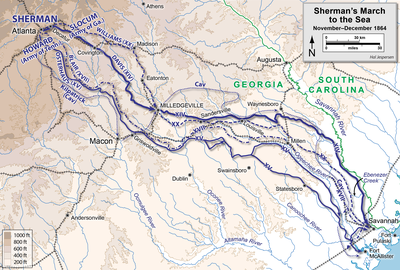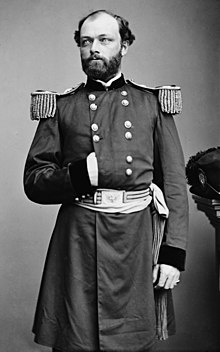150 years ago today, Fort Pulaski, near Savannah, Georgia, surrendered to the Federals. Fort Pulaski was built by the United States before the war to defend the seacoast. It was begun in 1830, and finished fifteen years later. It was named after Casimir Pulaski, who had come over to America from Poland to fight in the Revolution. He served gallantly as a cavalry officer, dieing in the Battle of Savannah, and was granted honorary American citizenship. It was occupied by the Confederates, and for a time Robert E. Lee oversaw the the work on its improvement when he was in command of the southern defenses. It was thought to be impregnable, and the Joseph Totten, US army engineer, said "you might as well bombard the Rocky Mountains." The Federals determined to attack it none the less, as part of their efforts to recapture and close Southern blockade running ports, and to provide a base for the blockading squadron. The Northern advance began in earnest on November 24th, 1861. They began a regular siege of Pulaski, completely surrounding it, building batteries, and preparing a 10,000 man force to storm the walls if necessary.
On the morning of April 10th, 150 years ago yesterday, David Hunter, Union commander, sent a message to the fort's commander, Colonel Olmstead, requesting his surrender. Olmstead replied, “I am here to defend the fort, not to surrender it.” The Federal bombardment opened at 8:00, focusing their fire on the southeast corner, and the Confederate batteries replied. The bombardment continued throughout the day. The Federal fire was from rifled guns and mortars. Rifled guns, with their longer range and greater accuracy, were a rather new innovation in siege warfare. The fire from these guns were very effective. By nightfall a breach was beginning in the wall, and many of the Confederate guns were damaged.

The firing was resumed at 7:00 on the morning of April 11th, 150 years ago today. Olmstead rose the white flag over the fort at 2 PM. A large breach had been made in the walls, exposing the powder magazine. If the battle had continued much longer, the Union shots would have hit the magazine, resulting in a catastrophic explosion, probably demolishing the fort.
The Federals had built splinter-proof shelters which worked very well. Although the Confederate fire was fairly accurate, they only inflicted 1 killed and a handful wounded. The Confederates casualties were not very high either, but all of the approximately 400 men of the garrison of the fort were surrendered, as well has many guns.
The mortars were found to be not useful in destroying the structure of the fort, although they could be effective in destroying the troop's morale. Only 10% of the mortar shots hit the fort. The rifled guns however were very satisfactory. It was found that they could easily destroy a brick fort at 2,500 yards. The success of the rifled artillery was very surprising to the commanders on both sides. The Federals had spent many months in preparations that were completely unnecessary, and the Confederates expected that the fort could hold out until they ran out of provisions.
Union general David Hunter said,
"The result of this bombardment must cause, I am convinced, a change in the construction of fortifications as radical as that forshadowed in naval architecture by the conflict between the Monitor and Merrimac. No works of stone or brick can resist the impact of rifled artillery of heavy caliber."
As Hunter, guess, rifled artillery would revolutionize fort design. After the Civil War, forts were no longer built of brick, instead earthworks were used.
Although Savannah would not fall until many months later when Sherman captured it at the conclusion of the March to the Sea, the capture of Fort Pulaski made the harbor useless to the Confederacy. The South had lost the use of an important port for blockade running, and the North had gained a base to continuing their blockade of the rest of the forts.






















